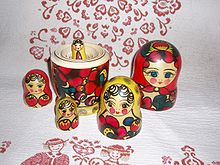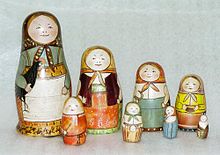Matryoshka
Matryoshka ( Russian Матрёшка , scientific transliteration : Matrëška ) are made of wood and brightly painted, nestable, egg-shaped Russian dolls with a talisman character.
overview
From linden or birch wood lathe-turned dolls as toys like enjoying a souvenir popular were first in 1890 by the painter Sergey Malyutin designed and the artisans Vasily Zvyozdochkin carved. A Fukurokuju doll imported from the Japanese island of Honshū is said to have served as inspiration . However, Fukurokuju dolls cannot be nested.
As toys that could be dismantled became increasingly popular in Russia towards the end of the 19th century, Svyosdotschkin and Malyutin made the matryoshkas in a nested construction. The wooden figures were supposed to represent a typical Russian peasant woman in a red sarafan . The name “Matrjoschka” is the diminutive of the Russian women's name “ Matrjona ”, which was widespread in the peasant milieu , and which in turn goes back to the Latin matrona or mater for mother (also in Russian мать , mat ′ or outdated / high-level language матерь , mater ′ ).
In addition to the female ones representing fertility and motherhood , there were also male variants, mostly representing martial ability and strength.
The now mostly female figures are made starting with the smallest doll. The next largest is then turned. The real art lies in the painting. The higher quality a set of matryoshkas, the less the big dolls differ from the small ones. The most famous places of manufacture are Nizhny Novgorod , Moscow Oblast and Kirov . Originally the dolls were only available in 3, 5, 7 and 10 pieces, but now they are also made in 13, 15 and 20 pieces (or even larger).
According to the Guinness Book of Records, the world record is 51 dolls and was set in the USA in 2003 . The largest figure measures 53.97 centimeters (1 foot 9 3 ⁄ 4 inches ) - the smallest only 0.31 centimeters ( 1 ⁄ 8 inches = 125 thou ).

There have also been satirical matryoshkas since the late 1980s . Here z. E.g. the smallest doll represents Lenin , Ivan the Terrible or Peter the Great and the largest Yeltsin or Putin .
Falsely these dolls are sometimes referred to as " babushka called" (including in the equally misspelling "Babutschka"), but in Russian, Grandma 'or' grandmother 'is and is not related to the dolls. In the Austrian border area with Hungary you can also find the name Piroschka ( Hungarian piroska ). The derivation “Mamuschka” from “Mama” is also incorrect. Other variants resulting from different or imprecise transcription of the Russian name are: Matryoshka, Matrioschka, Matryoschka (from the English transcription Matryoshka ), Matruschka or Maroschka.
literature
- Felix Philipp Ingold: Russian ways. History, culture, worldview . W. Fink, Munich 2007, ISBN 3-7705-4423-4 , p. 449, 450, 461 .
Web links
- History of the matryoshka on russlandjournal.de
Individual evidence
- ↑ James H. Billington: Russia in Search of Itself . Woodrow Wilson Center, Washington DC 2004, ISBN 978-0-8018-7976-0 , pp. 148 ( limited preview in Google Book Search [accessed August 14, 2016]).
- ↑ 19th Century Fukurokuju, Japanese God of Wisdom Doll (item # 775198). Retrieved May 15, 2019 .
- ↑ Largest Russian nesting doll (matryoshka). In: Guinness Book of Records . April 25, 2003, accessed July 31, 2019 .



